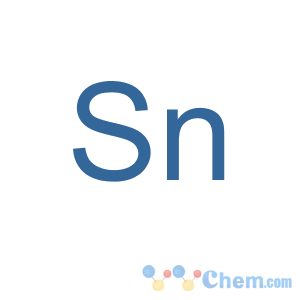Title: Tin
CAS Registry Number: 7440-31-5
Literature References: Sn; at. wt 118.710; at. no. 50; valence 2, 4. Group IVA (14). Naturally occurring isotopes: 112 (0.95%); 114 (0.65%); 115 (0.34%); 116 (14.24%); 117 (7.57%); 118 (24.01%); 119 (8.59%); 120 (32.97%); 122 (4.71%); 124 (5.98%); artificial, radioactive isotopes: 108-111; 113; 121; 123; 125-132. Found in cassiterite, stannite, and tealite. Occurrence in earth's crust: 6 ′ 10-4%. The metal of commerce is about 99.8% pure. Prepn of high purity tin: Baralis, Marone,
Met. Ital. 59, 494 (1967),
C.A. 67, 119613a (1967). Physical properties: Kirshenbaum, Cahill,
J. Inorg. Nucl. Chem. 25, 232 (1963).
Monograph: C. L. Mantell,
Tin: Its Mining, Production, Technology and Applications (Reinhold, New York, 1949).
Reviews: Abel in
Comprehensive Inorganic Chemistry vol. 2, J. C. Bailar, Jr.
et al., Eds. (Pergamon Press, Oxford, 1973) pp 43-104; W. Germain
et al., in
Kirk-Othmer Encyclopedia of Chemical Technology vol. 23 (Wiley-Interscience, New York, 3rd ed., 1983) pp 18-42. Review of toxicology and human exposure:
Toxicological Profile for Tin (PB2006-100006, 2005) 426 pp.
Properties: Silver-white, lustrous, soft, very malleable and ductile metal; only slightly tenacious; easily powdered. When being bent, emits the crackling "tin cry". Brittle at 200°. At -40° crumbles to gray amorphous powder ("gray tin"), slowly changing back above 20° to white tin. Available in the form of bars, foil, powder, shot, etc. Stable in air, but when in powder form it oxidizes, esp in presence of moisture. d 7.31. mp 231.9°. bp 2507° (2780 K). Specific heat (25°) 0.053 cal/g/°C. Brinell hardness 2.9. Insol in water. Reacts slowly with cold dil HCl or dil HNO3, hot dil H2SO4; readily with concd HCl, aqua regia; very slowly attacked by acetic acid; slowly attacked by cold, more readily by hot caustic alkali; concd HNO3 converts it into insol metastannic acid.
Melting point: mp 231.9°
Boiling point: bp 2507° (2780 K)
Density: d 7.31
CAUTION: Potential symptoms of overexposure to metallic tin are irritation of eyes, skin, respiratory system. Potential symptoms of overexposure to organic tin compounds are irritation of eyes, skin, respiratory system; headache, vertigo; psychoneurologic disturbances; sore throat, cough; abdominal pain, vomiting; urine retention; paresis, focal anesthesia; skin burns; pruritis.
See NIOSH Pocket Guide to Chemical Hazards (DHHS/NIOSH 97-140, 1997) p 308.
See also Patty's Industrial Hygiene and Toxicology vol. 2A, G. D. Clayton, F. E. Clayton, Eds. (Wiley-Interscience, New York, 3rd ed., 1981) pp 1940-1968.
Use: Chiefly for tin-plating and manuf of food, beverage and aerosol containers, soldering alloys, babbitt and type metals, manuf tin salts, collapsible tubes, coating for copper wire. Principle component in pewter. Alloys as dental materials (silver-tin-mercury), nuclear reactor components (tin-zirconium), aircraft components (tin-titanium), bronze (copper-tin), brass.

